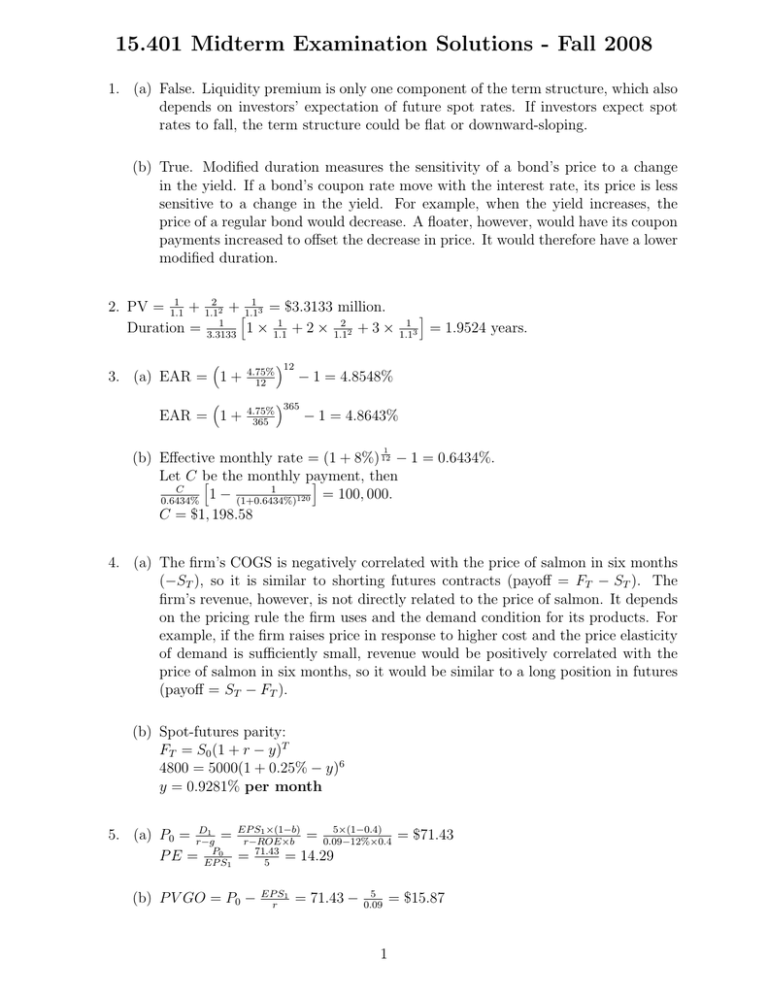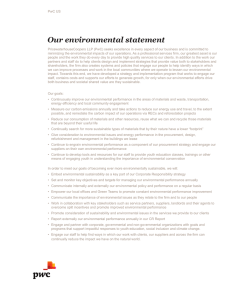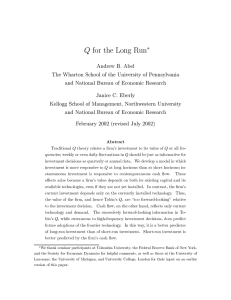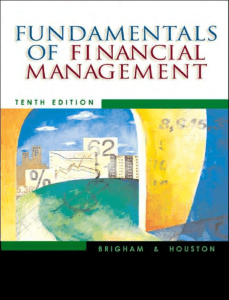15.401 Midterm Examination Solutions - Fall ...
advertisement

15.401 Midterm Examination Solutions - Fall 2008 1. (a) False. Liquidity premium is only one component of the term structure, which also depends on investors’ expectation of future spot rates. If investors expect spot rates to fall, the term structure could be flat or downward-sloping. (b) True. Modified duration measures the sensitivity of a bond’s price to a change in the yield. If a bond’s coupon rate move with the interest rate, its price is less sensitive to a change in the yield. For example, when the yield increases, the price of a regular bond would decrease. A floater, however, would have its coupon payments increased to offset the decrease in price. It would therefore have a lower modified duration. 1 2. PV = 1.1 + 1.12 2 + �1.11 3 = $3.3133 million. 1 1 Duration = 3.3133 1 × 1.1 + 2 × 1.12 2 + 3 × � 4.75% 12 � 4.75% 365 3. (a) EAR = 1 + EAR = 1 + �12 1 1.13 � = 1.9524 years. − 1 = 4.8548% �365 − 1 = 4.8643% 1 (b) Effective monthly rate = (1 + 8%) 12 − 1 = 0.6434%. Let C be then � the monthly payment, � C 1 1 − (1+0.6434%)120 = 100, 000. 0.6434% C = $1, 198.58 4. (a) The firm’s COGS is negatively correlated with the price of salmon in six months (−ST ), so it is similar to shorting futures contracts (payoff = FT − ST ). The firm’s revenue, however, is not directly related to the price of salmon. It depends on the pricing rule the firm uses and the demand condition for its products. For example, if the firm raises price in response to higher cost and the price elasticity of demand is sufficiently small, revenue would be positively correlated with the price of salmon in six months, so it would be similar to a long position in futures (payoff = ST − FT ). (b) Spot-futures parity: FT = S0 (1 + r − y)T 4800 = 5000(1 + 0.25% − y)6 y = 0.9281% per month S1 ×(1−b) 5×(1−0.4) D1 5. (a) P0 = r−g = EP = 0.09−12%×0.4 = $71.43 r−ROE×b P0 71.43 P E = EP S1 = 5 = 14.29 (b) P V GO = P0 − EP S1 r = 71.43 − 5 0.09 1 = $15.87 (c) P/E ratio will increase because (1) EP S1 stays constant (2) ROE > r ⇒ price increases with the plowback ratio. Higher plowback means that more earnings are reinvested in the firm rather than paid out as dividend. When ROE > r, the firm can generate a higher return on a given investment than the investors can, so the value of the additional reinvest­ ment is higher than the value of the loss dividend. The net effect is an increase in firm value and a higher stock price. To see this result mathematically, we note that P0 PE = = EP S1 EP S1 ×(1−b) r−g EP S1 = 1−b r−g Since g = ROE × b, PE = 1−b 1 1−b = r − ROE × b r 1 − ROE b r Since ROE > r, an increase in b reduces the denominator more than it does the numerator, so the ratio increases. 6. (a) r1 = 100 �95 − 1 = 5.2632% �1/2 100 r2 = 89.4 − 1 = 5.7624% 7 107 P V = 1+5.2632% + (1+5.7624%) 2 = $102.31 (b) Let Bonds A, B and C be the one-year zero-coupon, two-year zero-coupon and two-year coupon bonds, respectively. Since $104 > $102.31, Bond C is overval­ ued. The strategy should be to short C and long A and B. Suppose we short 1 C. we can offset the positive cashflow at t = 2 by buying 1.07 B. We can offset the positive cashflow at t = 1 by buying 0.07 A. An arbitrage portfolio is as follows: long 0.07 of Bond A; long 1.07 of Bond B; short 1 of Bond C. CF at 0 = −95 × 0.07 − 89.4 × 1.07 + 104 × 1 = $1.69 CF at 1 = 100 × 0.07 + 7 × (−1) = $0 CF at 2 = 100 × 1.07 + 107 × (−1) = $0 Any portfolio that has the form (0.07k, 1.07k, −k), k > 0 is an arbitrage portfolio that generates $1.69k at time 0 and no cashflow at any other time. 2 MIT OpenCourseWare http://ocw.mit.edu 15.401 Finance Theory I Fall 2008 For information about citing these materials or our Terms of Use, visit: http://ocw.mit.edu/terms.







